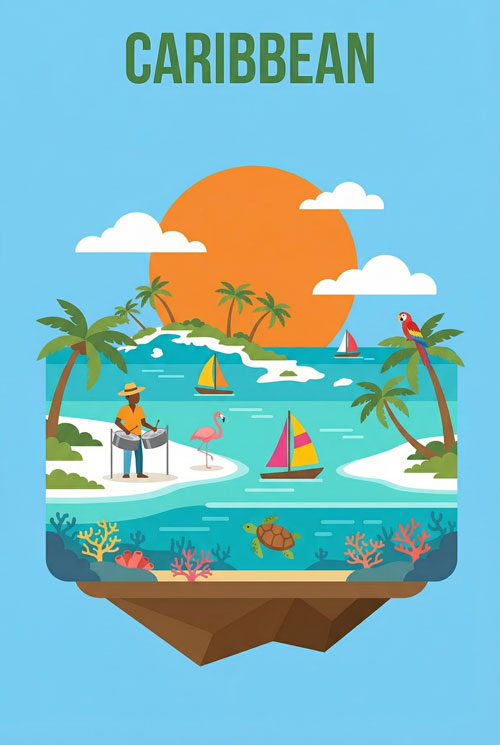Travel Guide, eSIM Indonesia
Bali Travel Guide: Everything You Need To Know
This Indonesian island, often called the ‘Island of the Gods’, truly offers something for everyone.
Imagine lush green rice paddies stretching to the horizon, ancient temples filled with spiritual energy, thrilling surf spots, vibrant nightlife, and deeply relaxing wellness retreats.
Planning your first trip can feel overwhelming, but don’t worry.
This guide cuts through the noise, giving you everything essential to plan an amazing Balinese adventure with ease and confidence.
We’ll cover the best times to go, how to get around, where to stay based on your vibe, must-see spots, staying safe and healthy, and respecting the unique local culture.
SVisa and Entry Explained
Getting into Bali is usually straightforward for many visitors. If you hold a passport from places like the UK or the US, you can typically get a 30-day tourist visa right when you land at the airport. Just be sure to double-check the very latest rules for your specific nationality before you fly, as things can change.
Expect the visa on arrival to cost around 500,000 Indonesian Rupiah (IDR), roughly £25 or $30 USD. You can often pay this with a card or cash. Want to speed things up at the airport? You might also have the option to apply for this visa online before your trip.
Crucially, make sure your passport is valid for at least six months beyond your planned stay in Bali. This is a standard requirement you don’t want to overlook.
When Should You Visit Bali? Timing Your Trip
Bali is tropical, meaning warm weather year-round. But there’s a distinct dry season and wet season to consider.
The dry season (April to October) is the most popular time. You’ll get lots of sunshine and less rain, making it perfect for beach days and exploring. This is peak season, so expect more crowds and potentially higher prices. Surfers love the west coast waves during this time.
The wet season (November to March) sees more rain, but it usually comes in short, heavy bursts, often in the afternoon. Don’t let this put you off entirely! The island becomes incredibly green and lush, especially around Ubud. Plus, you’ll find fewer tourists and possibly better deals on accommodation.
Looking for a sweet spot? Consider the shoulder seasons – April-May and October-November. You often get great weather, fewer crowds than peak season, and good surf conditions.
What to Pack: Think light and breathable. Linen and cotton clothing are your best friends in the humidity. Pack swimwear, comfy walking shoes, strong sunscreen, a hat, and insect repellent. Even in the dry season, a light rain jacket or small umbrella is a good idea for unexpected showers.
Money Matters: Currency and Payments
Bali uses the Indonesian Rupiah (IDR). While major hotels, restaurants, and shops in tourist areas accept credit and debit cards, you’ll definitely need cash. Many smaller shops, local eateries (warungs), temple entrance fees, and market stalls operate on a cash-only basis.
ATMs are easy to find in tourist hubs. Stick to using ATMs located at reputable banks or inside well-lit areas for safety. It’s smart to carry a mix of payment options – some cash and a card – so you’re prepared for anything.
Etiquette and Respect
Bali has a unique and deeply spiritual culture, primarily Balinese Hinduism. You’ll see spirituality woven into everyday life. Small offerings called Canang Sari, made from palm leaves, flowers, and incense, are placed everywhere daily as a sign of gratitude.
When you visit temples (and you definitely should!), dressing modestly is essential. Cover your shoulders and knees. Carrying a lightweight scarf or sarong with you is super helpful; you can easily wrap it around your waist or shoulders when needed. These are sacred places, so act respectfully – speak softly and be mindful of ceremonies.
Generally, Balinese people are incredibly kind and welcoming. Making a small effort to understand and respect their customs goes a long way and will enrich your interactions. A simple smile and a polite greeting can make a big difference.
Stay Connected With Mobile Data Instantly: SIM Cards vs. eSIMs in Bali
Having internet access on your phone in Bali is incredibly useful. You’ll want it for maps, booking rides, checking restaurant reviews, and staying in touch. You have two main options: getting a local physical SIM card or using an eSIM.
Physical SIM Cards:
- Pros: You can buy these easily upon arrival at the airport or in local phone shops. They can be very cheap, especially if you mainly need local calls/texts and some data.
- Cons: You need to physically swap out your home SIM card (don’t lose it!). Buying at the airport can sometimes be more expensive or involve pushy salespeople. Registration might be required, which can take time. Your phone needs to be unlocked.
- Best For: Travelers on a very tight budget who don’t mind the hassle of finding a shop and swapping SIMs, or those needing a local Indonesian phone number immediately from a physical store.
eSIM (Embedded SIM):
- Pros: Super convenient. You can buy and install it before you even leave home or right upon arrival using Wi-Fi. No physical swapping needed – your home SIM stays in place. Often connects automatically as soon as you land. Easy to manage data usage via an app.
- Cons: Your phone must be eSIM compatible and unlocked. Can sometimes seem slightly more expensive upfront than the absolute cheapest local SIM deal (but often offers better value for data packages). Requires an initial internet connection (like airport Wi-Fi or home Wi-Fi) to activate the first time.
- Best For: Travelers who value convenience and want instant connectivity upon landing. Ideal for those with newer, compatible smartphones. Great if you hop between countries frequently.
For a hassle-free option, consider using an eSIM provider. Companies like eSIM4.com offer affordable data plans specifically for Indonesia, often with features like automatically connecting to the best local network as soon as you arrive. Setup is typically simple, involving scanning a QR code or clicking a link sent via email after purchase. Having your data ready the moment you step off the plane avoids the stress of finding a SIM card vendor immediately. You can check out options and compare plans easily online at https://www.esim4.com/.
“Travel Tip: Having data access immediately upon landing in Bali is a game-changer for navigating to your hotel or letting family know you’ve arrived safely. An eSIM makes this incredibly easy.”
Getting Around Bali: Your Transport Options
Moving around Bali can be part of the adventure! Here are your main choices:
Rent a Scooter (If You’re Experienced): This is a very popular way to explore, offering freedom and flexibility, especially for shorter trips. However, safety first! Always wear a helmet. Critically, you now need an International Driving Permit (IDP) along with your regular license to legally ride a scooter in Bali. Be warned: traffic can be chaotic and roads narrow. Only rent a scooter if you are a confident and experienced rider.
Hire a Private Driver: For longer journeys, day trips, or if you’re traveling with family or friends, hiring a driver is a fantastic choice. It’s comfortable, stress-free, and surprisingly affordable (around $45 USD for a full 8-10 hour day). Drivers often act as informal guides, sharing local knowledge. You can usually arrange this through your hotel or find recommendations online.
Use Ride-Hailing Apps (Gojek & Grab): These apps are lifesavers in Bali! Gojek and Grab let you easily book cheap car or scooter taxis (ojek) using your phone. You’ll need internet access (another reason that eSIM comes in handy!). Using these apps is generally safer and more transparent with pricing than hailing random transport on the street. Avoid offers from individuals shouting “transport, transport!” or “bike, bike!” – stick to the apps.
Taxis: Regular taxis exist too. If you use one, Bluebird taxis are known for being reliable and always using the meter, ensuring you pay a fair price.
Be Ready for Traffic Jams: No matter how you choose to travel, Bali traffic can be intense. Seriously intense. Roads are often narrow, and the sheer number of scooters and cars means journeys can take much longer than you expect, even short distances on the map. Plan accordingly! Be patient, allow plenty of extra travel time in your schedule, and don’t try to cram too much into one day.
Where to Stay: Finding Your Ideal Bali Base
Bali offers diverse areas, each with a unique personality. Choosing where to stay depends on the kind of experience you’re looking for.
Ubud: Culture, Nature, and Calm Think lush rice fields, serene yoga retreats, art galleries, and ancient temples. Ubud, located inland, is Bali’s cultural heart. It’s perfect if you seek tranquility, spiritual experiences, and nature. Accommodation ranges from budget homestays to stunning luxury villas. Must-sees include the Tegalalang Rice Terraces and Tirta Empul Water Temple. Note: Being inland and greener, Ubud gets a bit more rain than coastal areas.
Seminyak & Canggu: Beach Vibes and Trendy Scenes These neighbouring coastal towns on the southwest coast are known for great beaches, buzzing nightlife, cool cafes, stylish boutiques, and famous beach clubs. Seminyak is a bit more upscale and polished, while Canggu has a laid-back surfer vibe popular with expats and digital nomads. Ideal if you want a mix of beach life, good food, sunsets, and entertainment. Be aware: Canggu, in particular, can suffer from heavy traffic congestion.
Uluwatu: Dramatic Cliffs and Epic Surf Located on the southern Bukit Peninsula, Uluwatu boasts stunning clifftop views over the Indian Ocean, world-class surfing waves, and chic beach clubs carved into the cliffs. The famous Uluwatu Temple sunset and Kecak dance are highlights. Accommodation leans towards luxury resorts and villas, but budget options exist near surf breaks. Uluwatu generally enjoys drier, sunnier weather. Perfect for surfers, couples seeking romantic views, and those wanting a touch of luxury.
Nusa Islands (Lembongan, Ceningan, Penida): Tropical Island Escape A short boat ride from Bali’s mainland lie these three islands. They offer a more relaxed, old-school island feel with beautiful white-sand beaches, crystal-clear turquoise water ideal for snorkeling and diving, and a slower pace. Nusa Penida is famed for dramatic spots like Kelingking Beach (the “T-Rex” cliff) and Diamond Beach, but requires more adventurous travel due to rougher roads and strong currents. Lembongan and Ceningan are smaller and easier to navigate. Ideal for a true island getaway feel.
Other Areas to Consider:
- Sanur: East coast, known for calm beaches, family-friendly vibe, and a more relaxed atmosphere.
- Munduk: Northern highlands, offers cooler temperatures, stunning waterfalls, hiking, and fewer crowds.
- East Bali (e.g., Amed, Sidemen): More traditional, less developed areas with beautiful rice fields, volcanoes, and diving spots. Offers a glimpse into authentic Balinese life.
Quick Guide to Bali’s Regions:
| Region | Key Characteristics | Top Attractions/Activities | Recommended For |
|---|---|---|---|
| Ubud | Cultural hub, rice paddies, spiritual, tranquil | Temples, yoga, rice terraces, Monkey Forest | Culture seekers, nature lovers, wellness enthusiasts |
| Seminyak | Beaches, vibrant nightlife, trendy, upscale | Beach clubs, restaurants, boutiques, sunsets | Partygoers, shoppers, those seeking modern comforts |
| Canggu | Beaches, relaxed surf scene, trendy cafes | Surfing, beach clubs, cafes, yoga studios | Surfers, digital nomads, bohemian vibe seekers |
| Uluwatu | Dramatic cliffs, world-class surfing, chic | Uluwatu Temple, Kecak dance, surfing, views | Surfers, luxury seekers, stunning coastal scenery fans |
| Nusa Islands | White sand, clear water, laid-back escape | Snorkeling, diving, Kelingking/Diamond Beach | Island escapists, water sports lovers |
| Sanur | Family-friendly, relaxed beaches | Calm beaches, water sports, quiet pace | Families, those wanting relaxed beach time |
| Munduk | Cooler climate, waterfalls, lush nature | Waterfalls, hiking, scenic tranquility | Nature lovers, hikers, those seeking cooler weather |
| East Bali | Traditional villages, natural beauty | Lempuyang Temple, Tirta Gangga, rice fields | Authentic experiences, divers, nature lovers |
Unforgettable Experiences: Top Things to See and Do
Bali is packed with amazing things to experience. Here are some highlights:
Hit the Beaches (Wisely): From the famous surf breaks of Uluwatu to the calmer sands of Sanur, Bali’s coastline is diverse. Nusa Penida’s Kelingking and Diamond Beaches offer jaw-dropping beauty. Remember, some beaches have strong currents, so be cautious when swimming, especially if you’re not experienced.
Explore Sacred Temples: You can’t visit Bali without seeing some of its thousands of temples (pura). Tirta Empul offers a unique holy water purification experience. Uluwatu Temple, perched on a cliff, provides incredible sunset views accompanied by the traditional Kecak fire dance – a must-do! Remember to dress respectfully (shoulders and knees covered).
Chase Waterfalls and Rice Paddies: Escape the coast and discover stunning waterfalls like Kanto Lampo or those hidden in the Munduk region. The Tegalalang Rice Terraces near Ubud are iconic, showcasing Bali’s ancient subak irrigation system (a UNESCO site). Hike through these green landscapes for amazing photos and a sense of peace.
Immerse Yourself in Culture: Watch a traditional Balinese dance performance like the hypnotic Kecak or elegant Legong. Visit artisan villages near Ubud (like Mas for wood carving or Celuk for silver) to see crafts being made. Trying a Balinese cooking class is a fun and delicious way to connect with the culture.
Adventure Time: Catch waves with a surf lesson (Kuta is good for beginners, Uluwatu for pros). Go snorkeling or diving, especially around the Nusa Islands or Amed, to see vibrant marine life. Hike up Mount Batur volcano for an unforgettable sunrise view (requires an early start!). Try white-water rafting for a thrill.
Relax and Rejuvenate: Bali, especially Ubud, is a world-renowned center for yoga and wellness. Join a yoga class, indulge in a traditional Balinese massage (they’re amazing and affordable!), or even book a multi-day wellness retreat.
Taste Bali: Food and Drink You Have to Try
Balinese food is fragrant, flavourful, and fresh. Don’t leave without trying these:
Must-Try Dishes:
- Nasi Goreng (fried rice) & Mie Goreng (fried noodles): Staple dishes, found everywhere.
- Sate Lilit: Minced meat satay, often fish or chicken, blended with Balinese spices and grilled on lemongrass sticks. Delicious!
- Gado-Gado: Indonesian salad with boiled vegetables, tofu, tempeh, and a rich peanut sauce.
- Babi Guling: Roasted suckling pig – a celebratory dish often found at specific restaurants or ceremonies.
- Fresh Seafood: Especially good in coastal areas like Jimbaran Bay.
Where to Eat:
- Warungs: Small, local, family-run eateries serving authentic Balinese food at super cheap prices. Seek them out!
- Trendy Cafes: Seminyak and Canggu are packed with stylish cafes serving everything from smoothie bowls to gourmet burgers.
- Restaurants with Views: From clifftop dining in Uluwatu to rice paddy views in Ubud, eating with a stunning backdrop is a special Bali experience.
Drinks to Know:
- Water: Critically important: Drink ONLY bottled water. Avoid tap water completely, even for brushing teeth. Be cautious with ice – in reputable hotels and restaurants it’s usually fine (made from purified water), but if in doubt, ask for drinks without ice (“tanpa es“). This is the #1 way to avoid stomach issues.
- Bintang: The most popular local beer.
- Fresh Juices & Coconuts: Widely available and refreshing.
- Kopi Luwak: The infamous “civet coffee,” if you’re curious (and mindful of ethical sourcing).
- Arak: A potent local spirit made from rice or palm sap. Try it cautiously!
Quick Tip: Don’t be afraid to eat at busy local warungs. Busy usually means the food is fresh, delicious, and safe!
Stay Safe and Healthy: Smart Travel Advice
Enjoying Bali means staying well. Here’s how to navigate potential health and safety concerns:
Avoiding “Bali Belly”: This unpleasant traveler’s diarrhea is common but largely preventable.
- Drink only sealed bottled water.
- Avoid ice unless you’re sure it’s made from purified water.
- Eat at places that look clean and popular (especially with locals).
- Wash your hands frequently or use hand sanitizer.
- Use bottled water to brush your teeth.
- If you get sick, stay hydrated with bottled water and consider electrolytes. See a doctor if symptoms are severe or last more than a couple of days. Pharmacies (apotek) are common and can offer advice for mild cases.
General Safety: Bali is generally very safe for tourists. However, petty theft like pickpocketing can happen, especially in crowded areas or nightlife spots.
- Keep valuables secure and out of sight. Don’t flash expensive jewelry or large amounts of cash.
- Be aware of your surroundings.
- There have been reports of bag/necklace snatching from people on motorbikes. Keep bags close, maybe wear backpacks on your front in busy areas, and tuck necklaces away.
Sun Protection is Serious: The tropical sun is strong, even on cloudy days.
- Wear high-SPF sunscreen religiously and reapply often, especially after swimming.
- Wear a hat and sunglasses.
- Stay hydrated by drinking lots of (bottled) water.
Mosquitoes: They are present, especially during the wet season and around dusk/dawn.
- Use insect repellent, particularly on exposed skin in the evenings.
- Some accommodations provide mosquito nets or coils.
Traffic Safety Revisited: It bears repeating: traffic is a major hazard. If riding a scooter, wear a helmet, have your IDP, be insured, and be extremely cautious. If you’re not a confident rider, don’t risk it. Use Gojek/Grab or hire a driver – it’s safer and less stressful.
Respect Local Laws: Indonesia has extremely strict laws against illegal drugs. Penalties are severe, including long prison sentences or worse. Do not get involved with drugs under any circumstances.
Quick Bali Dos and Don’ts
Do:
- Dress modestly when visiting temples (cover shoulders/knees).
- Use ride-hailing apps like Gojek or Grab for transport.
- Drink only sealed bottled water.
- Wear sunscreen and a hat.
- Be patient with traffic; allow extra time.
- Learn a few basic Indonesian phrases (Terima Kasih = Thank You, Sama Sama = You’re Welcome).
- Carry a sarong – useful for temples or even as a beach cover-up.
- Respect local customs and traditions; smile!
Don’t:
- Drink tap water or use it for brushing teeth.
- Flush toilet paper (use the bin provided next to the toilet).
- Underestimate travel times due to traffic.
- Display valuables openly.
- Touch people’s heads (considered sacred).
- Point with your index finger (use your thumb or whole hand).
- Ride a scooter without a helmet or proper license/IDP.
- Engage in arguments or raise your voice publicly (losing face is highly embarrassing).
- Support unethical animal tourism.
Sample Itinerary Ideas for Inspiration
Here are a couple of ideas to get you started, easily adaptable to your interests:
The Classic First Timer (1 Week):
- Days 1-3: Ubud: Arrive, transfer to Ubud. Explore rice terraces (Tegalalang), visit Tirta Empul temple, see the Monkey Forest. Enjoy yoga, art markets, cultural performances.
- Day 4: Day Trip Fun: Choose between a waterfall tour (like Tegenungan or Kanto Lampo) or a trip to the highlands for views of Mount Batur.
- Days 5-6: Seminyak/Canggu: Head to the coast. Relax on the beach, enjoy sunset drinks at a beach club, explore cafes and shops, maybe try a surf lesson.
- Day 7: Uluwatu & Departure: Travel south to Uluwatu. Visit the stunning cliffside temple, watch the Kecak dance at sunset. Enjoy a final Balinese meal before heading to the airport.
Deeper Dive (2 Weeks):
- Days 1-4: Ubud: Immerse yourself fully. Add a cooking class, explore more remote temples, hike through rice paddies, indulge in spa treatments.
- Days 5-7: Nusa Lembongan & Ceningan: Take a fast boat to Nusa Lembongan. Relax on Dream Beach, snorkel or dive, explore the island by scooter (including the Yellow Bridge to Nusa Ceningan).
- Days 8-10: Canggu/Seminyak: Return to the mainland. Enjoy the beach vibe at a slower pace. Focus on surfing, cafe hopping, shopping, or just relaxing by the pool.
- Days 11-12: Uluwatu: Explore the southern beaches (Padang Padang, Bingin), catch some world-class surf (or watch the pros), visit Uluwatu temple, enjoy cliffside dining.
- Days 13-14: Munduk or Sidemen (Choose Your Pace): Head north to Munduk for cool air, waterfalls, and mountain scenery OR east to Sidemen for tranquil rice fields and a glimpse of traditional village life before departure.
Ready to Embrace the Magic?
Bali truly lives up to its reputation as the Island of the Gods. It offers an incredible blend of natural beauty, vibrant culture, thrilling adventures, and peaceful moments. By planning ahead, understanding how to get around, choosing the right base, knowing what to see and do, and respecting the local way of life, you’re set for an unforgettable first trip.
Remember the key things: stay hydrated (with bottled water!), protect yourself from the sun, be mindful of traffic, dress respectfully at temples, and embrace the unexpected. Bali has a way of captivating visitors, leaving them with lasting memories and often, a desire to return.
Use this guide as your friendly companion, pack your sense of adventure (and that sarong!), and get ready to discover the unique magic that makes Bali so special.













